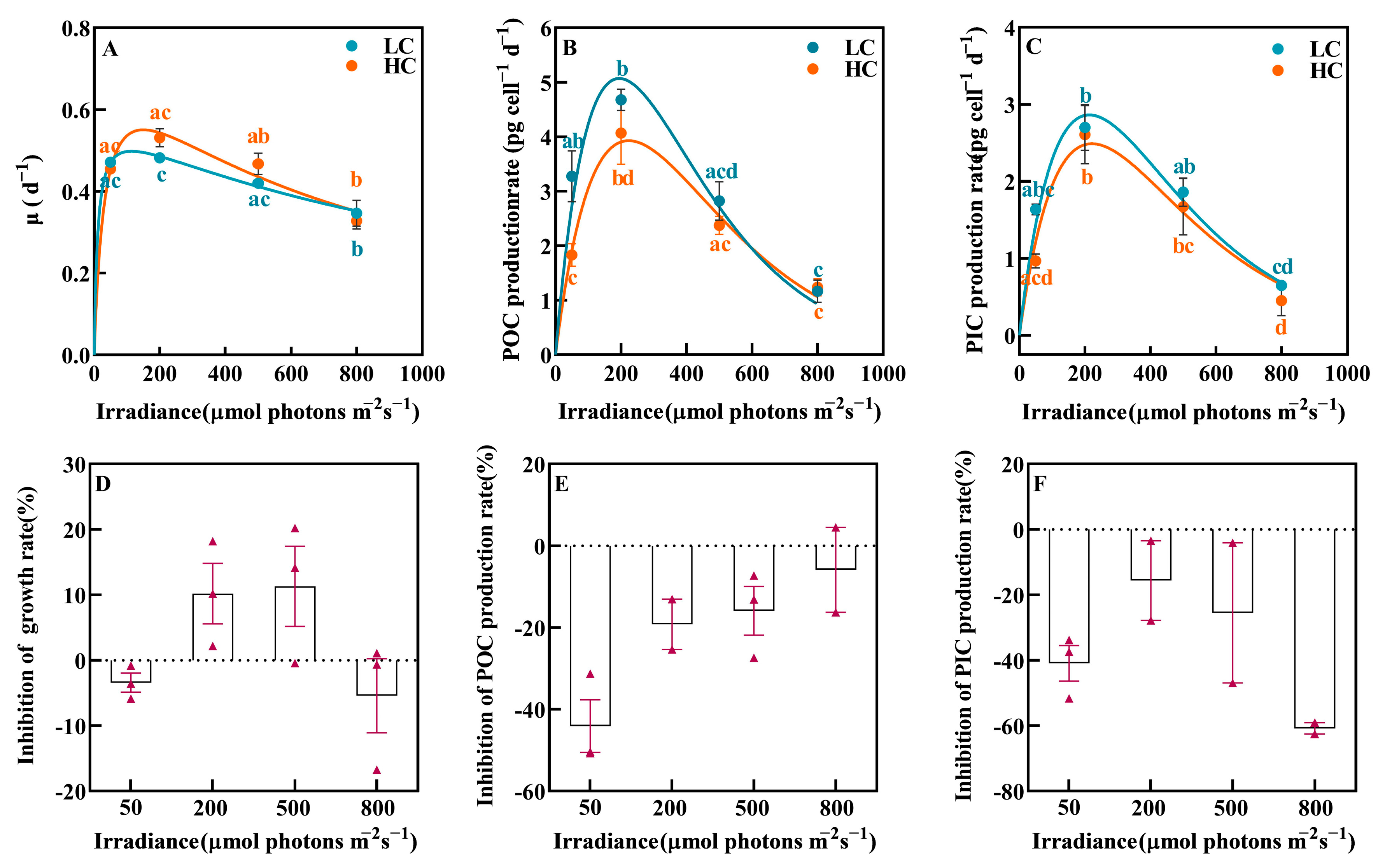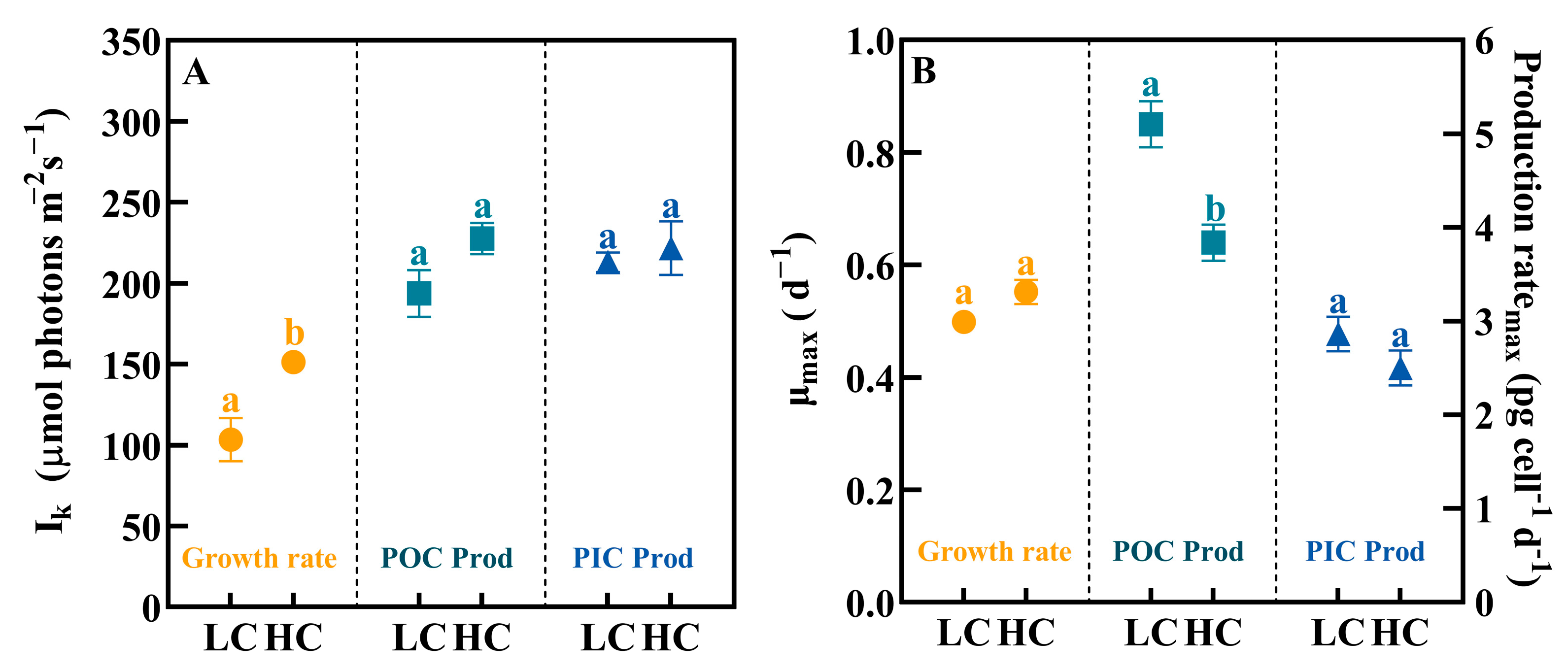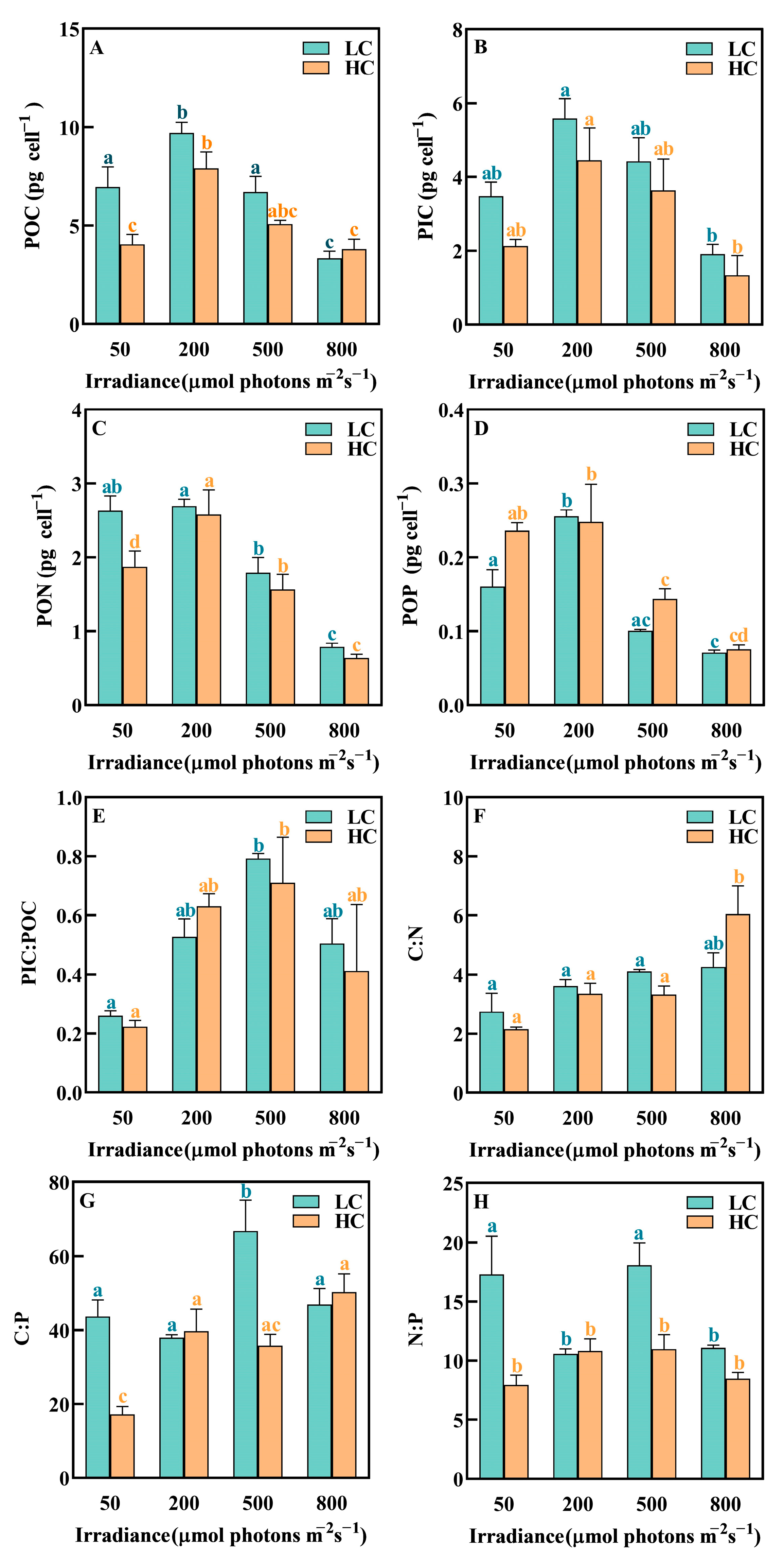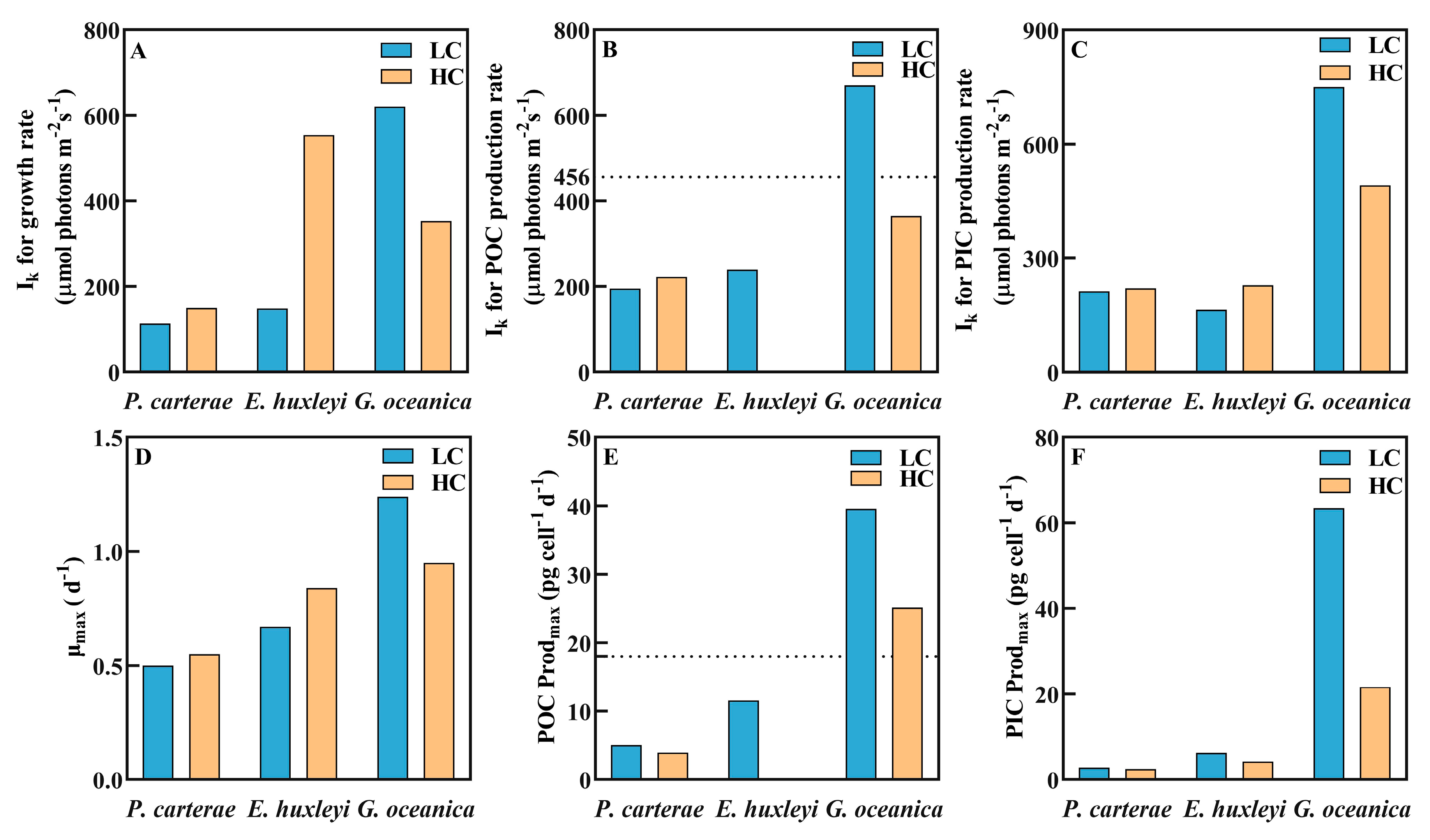Ocean Acidification Affects the Response of the Coastal Coccolithophore Pleurochrysis carterae to Irradiance
Abstract
:Simple Summary
Abstract
1. Introduction
2. Materials and Methods
2.1. Experimental Setup
2.2. Sample Analysis
2.2.1. Carbonate Chemistry Measurements
2.2.2. Cell Density, Growth Rate and Chlorophyll a
2.2.3. Elemental Contents and Cell Size
2.2.4. Data Analysis and Fitting
3. Results
3.1. Carbonate System in Experiments
3.2. Growth, POC and PIC Production Rate
3.3. Saturated Irradiance and the Maximum Value of Growth, POC and PIC Production Rates
3.4. The Chl.-a Content
3.5. Elemental Composition
4. Discussion
4.1. High Irradiance Inhibited the Physiological Processes
4.2. Acidification Affected the POC, PIC Production and the Elemental Compositions
4.3. Interactive Effects of OA and Irradiance

4.4. Species-Specific Responses of Coccolithophores
5. Conclusions
Supplementary Materials
Author Contributions
Funding
Institutional Review Board Statement
Informed Consent Statement
Data Availability Statement
Acknowledgments
Conflicts of Interest
References
- Gao, K.; Beardall, J.; Häder, D.-P.; Hall-Spencer, J.M.; Gao, G.; Hutchins, D.A. Effects of ocean acidification on marine photosynthetic organisms under the concurrent influences of warming, UV radiation, and deoxygenation. Front. Mar. Sci. 2019, 6, 322. [Google Scholar] [CrossRef]
- Shukla, P.R.; Skea, J.; Calvo Buendia, E.; Masson-Delmotte, V.; Pörtner, H.O.; Roberts, D.; Zhai, P.; Slade, R.; Connors, S.; Van Diemen, R. Climate Change and Land: An IPCC Special Report on Climate Change, Desertification, Land Degradation, Sustainable Land Management, Food Security, and Greenhouse Gas Fluxes in Terrestrial Ecosystems; IPCC: Geneva, Switzerland, 2019. [Google Scholar]
- Millero, F.J. The marine inorganic carbon cycle. Chem. Rev. 2007, 107, 308–341. [Google Scholar] [CrossRef]
- Merico, A.; Tyrrell, T.; Lessard, E.J.; Oguz, T.; Stabeno, P.J.; Zeeman, S.I.; Whitledge, T.E. Modelling phytoplankton succession on the Bering Sea shelf: Role of climate influences and trophic interactions in generating Emiliania huxleyi blooms 1997–2000. Deep. Sea Res. Part I Oceanogr. Res. Pap. 2004, 51, 1803–1826. [Google Scholar] [CrossRef]
- Heiden, J.P.; Kai, B.; Scarlett, T. Light Intensity Modulates the Response of Two Antarctic Diatom Species to Ocean Acidification. Front. Mar. Sci. 2016, 3, 260. [Google Scholar] [CrossRef]
- Holtz, L.-M.; Wolf-Gladrow, D.; Thoms, S. Simulating the effects of light intensity and carbonate system composition on particulate organic and inorganic carbon production in Emiliania huxleyi. J. Theor. Biol. 2015, 372, 192–204. [Google Scholar] [CrossRef]
- Broecker, W.; Clark, E.J.P. Ratio of coccolith CaCO3 to foraminifera CaCO3 in late Holocene deep sea sediments. Paleoceanogr. Paleoclimatology 2009, 24, PA3205. [Google Scholar]
- Wang, Y.; Feng, Y.; Li, T.; Cai, T.; Bai, Y. Strain specific responses of coccolithophore Emiliania huxleyi to warming and temperature fluctuation. Oceanol. Limnol. Sin. 2023, 54, 98–112. [Google Scholar]
- Poulton, A.J.; Adey, T.R.; Balch, W.M.; Holligan, P.M. Relating coccolithophore calcification rates to phytoplankton community dynamics: Regional differences and implications for carbon export. Deep. Sea Res. Part II Top. Stud. Oceanogr. 2007, 54, 538–557. [Google Scholar] [CrossRef]
- Langer, G.; Geisen, M.; Baumann, K.H.; Kläs, J.; Riebesell, U.; Thoms, S.; Young, J.R. Species-specific responses of calcifying algae to changing seawater carbonate chemistry. Geochem. Geophys. Geosyst. 2006, 7, Q09006. [Google Scholar] [CrossRef]
- Langer, G.; Nehrke, G.; Probert, I.; Ly, J.; Ziveri, P. Strain-specific responses of Emiliania huxleyi to changing seawater carbonate chemistry. Biogeosciences 2009, 6, 2637–2646. [Google Scholar] [CrossRef]
- Rivero-Calle, S.; Gnanadesikan, A.; Del Castillo, C.E.; Balch, W.M.; Guikema, S.D. Multidecadal increase in North Atlantic coccolithophores and the potential role of rising CO2. Science 2015, 350, 1533–1537. [Google Scholar] [CrossRef] [PubMed]
- Zhang, Y.; Collins, S.; Gao, K. Reduced growth with increased quotas of particulate organic and inorganic carbon in the coccolithophore Emiliania huxleyi under future ocean climate change conditions. Biogeosciences 2020, 17, 6357–6375. [Google Scholar] [CrossRef]
- O’dea, S.A.; Gibbs, S.J.; Bown, P.R.; Young, J.R.; Poulton, A.J.; Newsam, C.; Wilson, P.A. Coccolithophore calcification response to past ocean acidification and climate change. Nat. Commun. 2014, 5, 5363. [Google Scholar] [CrossRef] [PubMed]
- Bolton, C.T.; Hernández-Sánchez, M.T.; Fuertes, M.-Á.; González-Lemos, S.; Abrevaya, L.; Mendez-Vicente, A.; Flores, J.-A.; Probert, I.; Giosan, L.; Johnson, J. Decrease in coccolithophore calcification and CO2 since the middle Miocene. Nat. Commun. 2016, 7, 10284. [Google Scholar] [CrossRef] [PubMed]
- Beaufort, L.; Probert, I.; de Garidel-Thoron, T.; Bendif, E.M.; Ruiz-Pino, D.; Metzl, N.; Goyet, C.; Buchet, N.; Coupel, P.; Grelaud, M. Sensitivity of coccolithophores to carbonate chemistry and ocean acidification. Nature 2011, 476, 80–83. [Google Scholar] [CrossRef]
- Feng, Y.; Roleda, M.Y.; Armstrong, E.; Summerfield, T.C.; Law, C.S.; Hurd, C.L.; Boyd, P.W. Effects of multiple drivers of ocean global change on the physiology and functional gene expression of the coccolithophore Emiliania huxleyi. Glob. Chang. Biol. 2020, 26, 5630–5645. [Google Scholar] [CrossRef] [PubMed]
- Iglesias-Rodriguez, M.D.; Halloran, P.R.; Rickaby, R.E.; Hall, I.R.; Colmenero-Hidalgo, E.; Gittins, J.R.; Green, D.R.; Tyrrell, T.; Gibbs, S.J.; Von Dassow, P. Phytoplankton calcification in a high-CO2 world. Science 2008, 320, 336–340. [Google Scholar] [CrossRef]
- Gafar, N.A.; Eyre, B.D.; Schulz, K.G. A comparison of species specific sensitivities to changing light and carbonate chemistry in calcifying marine phytoplankton. Sci. Rep. 2019, 9, 2486. [Google Scholar] [CrossRef]
- Halsey, K.H.; Jones, B.M. Phytoplankton strategies for photosynthetic energy allocation. Annu. Rev. Mar. Sci. 2015, 7, 265–297. [Google Scholar] [CrossRef]
- Iglesias-Rodríguez, M.D.; Brown, C.W.; Doney, S.C.; Kleypas, J.; Kolber, D.; Kolber, Z.; Hayes, P.K.; Falkowski, P.G. Representing key phytoplankton functional groups in ocean carbon cycle models: Coccolithophorids. Glob. Biogeochem. Cycles 2002, 16, 47-1–47-20. [Google Scholar] [CrossRef]
- Feng, Y.; Roleda, M.Y.; Armstrong, E.; Boyd, P.W.; Hurd, C.L. Environmental controls on the growth, photosynthetic and calcification rates of a Southern Hemisphere strain of the coccolithophore Emiliania huxleyi. Limnol. Oceanogr. 2017, 62, 519–540. [Google Scholar] [CrossRef]
- Xie, E.; Xu, K.; Li, Z.; Li, W.; Yi, X.; Li, H.; Han, Y.; Zhang, H.; Zhang, Y. Disentangling the Effects of Ocean Carbonation and Acidification on Elemental Contents and Macromolecules of the Coccolithophore Emiliania huxleyi. Front. Microbiol. 2021, 12, 3188. [Google Scholar] [CrossRef] [PubMed]
- Frada, M.J.; Bendif, E.M.; Keuter, S.; Probert, I. The private life of coccolithophores. Perspect. Phycol. 2019, 6, 11–30. [Google Scholar] [CrossRef]
- Guillard, R.R.; Ryther, J.H. Studies of marine planktonic diatoms: I. Cyclotella nana Hustedt, and Detonula confervacea (Cleve) Gran. Can. J. Microbiol. 1962, 8, 229–239. [Google Scholar] [CrossRef]
- Feng, Y.; Chai, F.; Wells, M.L.; Liao, Y.; Li, P.; Cai, T.; Zhao, T.; Fu, F.; Hutchins, D.A. The combined effects of increased pCO2 and warming on a coastal phytoplankton assemblage: From species composition to sinking rate. Front. Mar. Sci. 2021, 8, 622319. [Google Scholar] [CrossRef]
- Yang, Y.; Gao, K. Effects of CO2 concentrations on the freshwater microalgae, Chlamydomonas reinhardtii, Chlorella pyrenoidosa and Scenedesmus obliquus (Chlorophyta). J. Appl. Phycol. 2003, 15, 379–389. [Google Scholar] [CrossRef]
- Cai, T.; Feng, Y.; Wang, Y.; Li, T.; Wang, J.; Li, W.; Zhou, W. The Differential Responses of Coastal Diatoms to Ocean Acidification and Warming: A Comparison Between Thalassiosira sp. and Nitzschia closterium f. minutissima. Front. Microbiol. 2022, 13, 851149. [Google Scholar] [CrossRef] [PubMed]
- Dickson, A.; Millero, F.J. A comparison of the equilibrium constants for the dissociation of carbonic acid in seawater media. Deep. Sea Res. Part A Oceanogr. Res. Pap. 1987, 34, 1733–1743. [Google Scholar] [CrossRef]
- Utermöhl, H. Zur vervollkommnung der quantitativen phytoplankton-methodik: Mit 1 Tabelle und 15 abbildungen im Text und auf 1 Tafel. Int. Ver. Für Theor. Angew. Limnol. Mitteilungen 1958, 9, 1–38. [Google Scholar] [CrossRef]
- Brading, P.; Warner, M.E.; Davey, P.; Smith, D.J.; Achterberg, E.P.; Suggett, D.J. Differential effects of ocean acidification on growth and photosynthesis among phylotypes of Symbiodinium (Dinophyceae). Limnol. Oceanogr. 2011, 56, 927–938. [Google Scholar] [CrossRef]
- Welschmeyer, N.A. Fluorometric analysis of chlorophyll a in the presence of chlorophyll b and pheopigments. Limnol. Oceanogr. 1972, 39, 1985–1992. [Google Scholar] [CrossRef]
- Fabry, V.J.; Balch, W.M. Direct measurements of calcification rates in planktonic organisms. In Guide to Best Practices for Ocean Acidification Research and Data Reporting; Publications Office of the European Union: Luxembourg, 2010; pp. 201–212. [Google Scholar]
- Solórzano, L.; Sharp, J.H. Determination of total dissolved phosphorus and particulate phosphorus in natural waters 1. Limnol. Oceanogr. 1980, 25, 754–758. [Google Scholar] [CrossRef]
- Eilers, P.H.C.; Peeters, J.C.H. A model for the relationship between light intensity and the rate of photosynthesis in phytoplankton. Ecol. Model. 1988, 42, 199–215. [Google Scholar] [CrossRef]
- Steele, J.H. Environmental control of photosynthesis in the sea. Limnol. Oceanogr. 1962, 7, 137–150. [Google Scholar] [CrossRef]
- Oliveira, C.Y.B.; Abreu, J.L.; Santos, E.P.; Matos, Â.P.; Tribuzi, G.; Oliveira, C.D.L.; Veras, B.O.; Bezerra, R.S.; Müller, M.N.; Gálvez, A.O. Light induces peridinin and docosahexaenoic acid accumulation in the dinoflagellate Durusdinium glynnii. Appl. Microbiol. Biotechnol. 2022, 106, 6263–6276. [Google Scholar] [CrossRef]
- Gururani, M.A.; Venkatesh, J.; Tran, L.S.P. Regulation of photosynthesis during abiotic stress-induced photoinhibition. Mol. Plant 2015, 8, 1304–1320. [Google Scholar] [CrossRef]
- Szabó, I.; Bergantino, E.; Giacometti, G.M. Light and oxygenic photosynthesis: Energy dissipation as a protection mechanism against photo-oxidation. EMBO Rep. 2005, 6, 629–634. [Google Scholar] [CrossRef]
- Hirayama, S.; Ueda, R.; Sugata, K. Effect of hydroxyl radical on intact microalgal photosynthesis. Energy Convers. Manag. 1995, 36, 685–688. [Google Scholar] [CrossRef]
- Edelman, M.; Mattoo, A.K. D1-protein dynamics in photosystem II: The lingering enigma. Photosynth. Res. 2008, 98, 609–620. [Google Scholar] [CrossRef]
- Tong, S.; Hutchins, D.A.; Fu, F.; Gao, K. Effects of varying growth irradiance and nitrogen sources on calcification and physiological performance of the coccolithophore Gephyrocapsa oceanica grown under nitrogen limitation. Limnol. Oceanogr. 2016, 61, 2234–2242. [Google Scholar] [CrossRef]
- Wagner, H.; Jakob, T.; Wilhelm, C. Balancing the energy flow from captured light to biomass under fluctuating light conditions. New Phytol. 2006, 169, 95–108. [Google Scholar] [CrossRef]
- Kottmeier, D.M.; Chrachri, A.; Langer, G.; Helliwell, K.E.; Wheeler, G.L.; Brownlee, C. Reduced H+ channel activity disrupts pH homeostasis and calcification in coccolithophores at low ocean pH. Proc. Natl. Acad. Sci. USA 2022, 119, e2118009119. [Google Scholar] [CrossRef]
- Brownlee, C.; Wheeler, G.L.; Taylor, A.R. Coccolithophore biomineralization: New questions, new answers. Semin. Cell Dev. Biol. 2015, 46, 11–16. [Google Scholar] [CrossRef]
- Jin, P.; Wang, T.; Liu, N.; Dupont, S.; Beardall, J.; Boyd, P.W.; Riebesell, U.; Gao, K. Ocean acidification increases the accumulation of toxic phenolic compounds across trophic levels. Nat. Commun. 2015, 6, 8714. [Google Scholar] [CrossRef]
- Coleman, J.R.; Colman, B. Inorganic carbon accumulation and photosynthesis in a blue-green alga as a function of external pH. Plant Physiol. 1981, 67, 917–921. [Google Scholar] [CrossRef]
- Werdan, K.; Heldt, H.W.; Milovancev, M. The role of pH in the regulation of carbon fixation in the chloroplast stroma. Studies on CO2 fixation in the light and dark. Biochim. Biophys. Acta (BBA)-Bioenerg. 1975, 396, 276–292. [Google Scholar] [CrossRef]
- Buitenhuis, E.T.; De Baar, H.J.; Veldhuis, M.J. Photosynthesis and calcification by Emiliania huxleyi (Prymnesiophyceae) as a function of inorganic carbon species. J. Phycol. 1999, 35, 949–959. [Google Scholar] [CrossRef]
- Bach, L.T.; Mackinder, L.C.; Schulz, K.G.; Wheeler, G.; Schroeder, D.C.; Brownlee, C.; Riebesell, U. Dissecting the impact of CO2 and pH on the mechanisms of photosynthesis and calcification in the coccolithophore Emiliania huxleyi. New Phytol. 2013, 199, 121–134. [Google Scholar] [CrossRef]
- Brownlee, C.; Langer, G.; Wheeler, G.L. Coccolithophore calcification: Changing paradigms in changing oceans. Acta Biomater. 2021, 120, 4–11. [Google Scholar] [CrossRef] [PubMed]
- Mackinder, L.; Wheeler, G.; Schroeder, D.; von Dassow, P.; Riebesell, U.; Brownlee, C. Expression of biomineralization-related ion transport genes in Emiliania huxleyi. Environ. Microbiol. 2011, 13, 3250–3265. [Google Scholar] [CrossRef]
- Taylor, A.R.; Chrachri, A.; Wheeler, G.; Goddard, H.; Brownlee, C. A voltage-gated H+ channel underlying pH homeostasis in calcifying coccolithophores. PLoS Biol. 2011, 9, e1001085. [Google Scholar] [CrossRef] [PubMed]
- Ziveri, P.; Passaro, M.; Incarbona, A.; Milazzo, M.; Rodolfo-Metalpa, R.; Hall-Spencer, J.M. Decline in coccolithophore diversity and impact on coccolith morphogenesis along a natural CO2 gradient. Biol. Bull. 2014, 226, 282–290. [Google Scholar] [CrossRef] [PubMed]
- Zhang, Y.; Li, Z.; Schulz, K.G.; Hu, Y.; Irwin, A.J.; Finkel, Z.V. Growth-dependent changes in elemental stoichiometry and macromolecular allocation in the coccolithophore Emiliania huxleyi under different environmental conditions. Limnol. Oceanogr. 2021, 66, 2999–3009. [Google Scholar] [CrossRef]
- Zhang, Y.; Fu, F.; Hutchins, D.A.; Gao, K. Combined effects of CO2 level, light intensity, and nutrient availability on the coccolithophore Emiliania huxleyi. Hydrobiologia 2019, 842, 127–141. [Google Scholar] [CrossRef]
- Wu, S.; Mi, T.; Zhen, Y.; Yu, K.; Wang, F.; Yu, Z. A rise in ROS and EPS production: New insights into the Trichodesmium erythraeum response to ocean acidification. J. Phycol. 2020, 1, 172–182. [Google Scholar] [CrossRef] [PubMed]
- Jin, P.; Ding, J.; Xing, T.; Riebesell, U.; Gao, K. High levels of solar radiation offset impacts of ocean acidification on calcifying and non-calcifying strains of Emiliania huxleyi. Mar. Ecol. Prog. 2017, 568, 47–58. [Google Scholar] [CrossRef]
- Zhang, Y.; Bach, L.T.; Schulz, K.G.; Riebesell, U. The modulating effect of light intensity on the response of the coccolithophore Gephyrocapsa oceanica to ocean acidification. Limnol. Oceanogr. 2015, 60, 2145–2157. [Google Scholar] [CrossRef]
- Bach, L.T.; Riebesell, U.; Schulz, K.G. Distinguishing between the effects of ocean acidification and ocean carbonation in the coccolithophore Emiliania huxleyi. Limnol. Oceanogr. 2011, 56, 2040–2050. [Google Scholar] [CrossRef]
- Keeling, P.J.; Burki, F.; Wilcox, H.M.; Allam, B.; Allen, E.E.; Amaral-Zettler, L.A.; Armbrust, E.V.; Archibald, J.M.; Bharti, A.K.; Bell, C.J. The Marine Microbial Eukaryote Transcriptome Sequencing Project (MMETSP): Illuminating the functional diversity of eukaryotic life in the oceans through transcriptome sequencing. PLoS Biol. 2014, 12, e1001889. [Google Scholar] [CrossRef] [PubMed]
- Read, B.A.; Kegel, J.; Klute, M.J.; Kuo, A.; Lefebvre, S.C.; Maumus, F.; Mayer, C.; Miller, J.; Monier, A.; Salamov, A. Pan genome of the phytoplankton Emiliania underpins its global distribution. Nature 2013, 499, 209–213. [Google Scholar] [CrossRef]





| Treatment | pHNBS | TA μmol kg−1 | DIC μmol kg−1 | [HCO3−] μmol kg−1 | [CO32−] μmol kg−1 | CO2 ppm |
|---|---|---|---|---|---|---|
| 50 μmol photons m−2·s−1 +400 ppm | 8.16 ± 0.03 a | 2303 ± 8 a | 2083 ± 5 a | 1927 ± 11 a | 140 ± 8 a | 420 ± 29 a |
| 50 μmol photons m−2·s−1 +800 ppm | 7.91 ± 0.01 b | 2354 ± 3 b | 2229 ± 2 b | 2111 ± 2 b | 86 ± 2 bc | 812 ± 17 b |
| 200 μmol photons m−2·s−1 +400 ppm | 8.17 ± 0.00 a | 2299 ± 12 a | 2074 ± 9 a | 1916 ± 8 a | 143 ± 2 a | 405 ± 3 a |
| 200 μmol photons m−2·s−1 +800 ppm | 7.98 ± 0.02 c | 2265 ± 8 a | 2135 ± 16 c | 2045 ± 8 cd | 77 ± 0 b | 857 ± 8 b |
| 500 μmol photons m−2·s−1 +400 ppm | 8.16 ± 0.02 a | 2278 ± 6 ab | 2062 ± 6 ab | 1909 ± 11 a | 137 ± 7 a | 420 ± 27 a |
| 500 μmol photons m−2·s−1 +800 ppm | 7.88 ± 0.01 b | 2277 ± 39 a | 2159 ± 11 cd | 2015 ± 21 c | 94 ± 8 c | 685 ± 39 c |
| 800 μmol photons m−2·s−1 +400 ppm | 8.14 ± 0.01 a | 2239 ± 15 b | 2035 ± 13 b | 1889 ± 11 a | 129 ± 2 a | 435 ± 6 a |
| 800 μmol photons m−2·s−1 +800 ppm | 7.91 ± 0.01 bc | 2296 ± 7 a | 2173 ± 3 d | 2059 ± 2 d | 84 ± 2 bc | 798 ± 17 b |
| Parameters | CO2 | Irradiance | Irradiance × CO2 | ||||||
|---|---|---|---|---|---|---|---|---|---|
| df | F | p | df | F | p | df | F | p | |
| Growth rate | 1 | 1.30 | 0.27 | 3 | 28.27 | <0.01 * | 3 | 1.97 | 0.16 |
| Chl.-a | 1 | 2.51 | 0.13 | 3 | 103.2 | <0.01 * | 3 | 0.72 | 0.55 |
| POC | 1 | 10.69 | 0.01 * | 3 | 21.55 | <0.01 * | 3 | 2.61 | 0.09 |
| PIC | 1 | 4.94 | 0.04 * | 3 | 12.69 | <0.01 * | 3 | 0.16 | 0.92 |
| PON | 1 | 5.22 | 0.04 * | 3 | 39.43 | <0.01 * | 3 | 1.27 | 0.32 |
| POP | 1 | 3.82 | 0.07 | 3 | 28.75 | <0.01 * | 3 | 1.65 | 0.22 |
| C/N | 1 | 0.01 | 0.93 | 3 | 10.23 | <0.01 * | 3 | 2.78 | 0.08 |
| C/P | 1 | 15.22 | <0.01 * | 3 | 8.51 | <0.01 * | 3 | 7.38 | <0.01 * |
| N/P | 1 | 20.22 | <0.01 * | 3 | 3.85 | 0.03 * | 3 | 4.49 | 0.02 * |
| PIC/POC | 1 | 0.05 | 0.83 | 3 | 1.88 | 0.17 | 3 | 0.20 | 0.89 |
| POC Prod | 1 | 8.26 | 0.01 * | 3 | 35.32 | <0.01 * | 3 | 2.35 | 0.11 |
| PIC Prod | 1 | 2.91 | 0.11 | 3 | 27.32 | <0.01 * | 3 | 0.59 | 0.63 |
Disclaimer/Publisher’s Note: The statements, opinions and data contained in all publications are solely those of the individual author(s) and contributor(s) and not of MDPI and/or the editor(s). MDPI and/or the editor(s) disclaim responsibility for any injury to people or property resulting from any ideas, methods, instructions or products referred to in the content. |
© 2023 by the authors. Licensee MDPI, Basel, Switzerland. This article is an open access article distributed under the terms and conditions of the Creative Commons Attribution (CC BY) license (https://creativecommons.org/licenses/by/4.0/).
Share and Cite
Wu, F.; Guo, J.; Duan, H.; Li, T.; Wang, Y.; Wang, Y.; Wang, S.; Feng, Y. Ocean Acidification Affects the Response of the Coastal Coccolithophore Pleurochrysis carterae to Irradiance. Biology 2023, 12, 1249. https://doi.org/10.3390/biology12091249
Wu F, Guo J, Duan H, Li T, Wang Y, Wang Y, Wang S, Feng Y. Ocean Acidification Affects the Response of the Coastal Coccolithophore Pleurochrysis carterae to Irradiance. Biology. 2023; 12(9):1249. https://doi.org/10.3390/biology12091249
Chicago/Turabian StyleWu, Fengxia, Jia Guo, Haozhen Duan, Tongtong Li, Yanan Wang, Yuntao Wang, Shiqiang Wang, and Yuanyuan Feng. 2023. "Ocean Acidification Affects the Response of the Coastal Coccolithophore Pleurochrysis carterae to Irradiance" Biology 12, no. 9: 1249. https://doi.org/10.3390/biology12091249
APA StyleWu, F., Guo, J., Duan, H., Li, T., Wang, Y., Wang, Y., Wang, S., & Feng, Y. (2023). Ocean Acidification Affects the Response of the Coastal Coccolithophore Pleurochrysis carterae to Irradiance. Biology, 12(9), 1249. https://doi.org/10.3390/biology12091249










